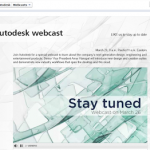When I hear ‘Chris Zoog‘, I can’t help but think of his 2003 brainchild, the 6 phases of a Revit user…
More recently (ie. this week), Chris delivered a webcast on the usefulness of IFC for NYC-RUG and gave his permission that it be uploaded to the web. See the whole webcast embedded below:
So here is the breadcrumb of credit–
Created by Chris Zoog, uploaded to Dropbox by theoryshaw, put on Youtube by BenPMalone.
In the webcast, Chris talks about (among other things):
- history of IFC
- using Grasshopper and Geometry Gym plugins with Revit (see my previous posts)
- drofus
- Generic Model Adaptive Components used in simulation
- clash detection / code compliance
- Tekla Bimsight / Solibri Model Checker
- “Navisworks is ubiquitous but this (Solibri) is the better tool”
- BCF – BIM Collaboration format
- the IFCExportAs parameter for non-system families in Revit
- arr-chee-cad (57:15)
It is recommended viewing if you are interested in the current uses of IFC and he also hints at what the future may hold…
A summary of the webcast from LinkedIn:
Jeffrey Ouellette • Well, he showed several:
1. Design & Documentation – A set of formal parametric design constraints were developed in Rhino using Grasshopper, tagged with IFC data and then exported as IFC files and imported into Revit. The objects were translated into Revit-native data structures (some better than others). The design work would be VERY difficult, if at all possible, in Revit, so he showed that using a design tool built for such purposes could still exchange the model data with the preferred documentation platform, totally different technologies, using IFC. Granted the connection was based on IFC4….
2. Planning & Design. dRofus is a very powerful web-based, database-centric, planning and facility data management tool. Via IFC exchanges, he showed how owner program requirements, developed most efficiently in dRofus, could be transferred to Revit via IFC2x3. Also designs in Revit could be re-imported into dRofus to compare and verify the model design against the requirements, AUTOMATICALLY!
3. Clash Detection/Coordination. Yes, Revit and Navisworks can talk to each other with a high degree of ease and fidelity now, but he showed how Solibri Model Checker (SMC), an IFC model based BIM tool, can find, report, and share this information in a variety of ways, including sharing model comments between platforms via BCF.
4. Code checking. Using Solibri Model Checker (SMC), a Revit design model is exported via IFC and examined for exiting, occupancy, and critical clearances using logical rules based on code requirements, such as IBC.
5. QA/QC. Beyond just using SMC for code compliance and clash detection, SMC can be used to determine the quality and validity of a BIM, both geometry and data, with rules based on a particular domain or even between domains.
What was most impressive was that it was working, given the reputation for Autodesk’s previous interoperability efforts, but noted recent improvements in support.
He was able to demonstrate that there was no excuse for being able to use IFC-based workflows TODAY, even with Revit. You just have to learn and do. My old Kendo sensei would always say, “Don’t TRY, just DO”. He wanted us to understand the importance of removing the abstract from the shinai (bamboo sword) being an analogy of a metal blade to moving, behaving, reacting to it BEING a real blade. If you merely try, then you fail and give up because you feel there is no consequence. But, if you act as if your life is on the line, then you will only stumble for a while as you get better.
via
Which file formats? Struggling to decide… | LinkedIn
2gb file
via
IFC Info – ThinkBIM™
Heads-up:
Hi @zoog, @nycrug great presentation on #IFC/OpenBIM, ended up recording it 4 U guys. bit.ly/VKplNF Video’s huge though…2gigs. 😐
— Ryan Schultz (@theoryshaw) January 16, 2013
@zoog we may have a solution … Check out link thanks to @theoryshaw sites.google.com/a/revitall.net…
— ThinkBIM™(@revitall) January 16, 2013




Linkback to IFC – What It Is and Why You Should Care: Chris Zoog’s NYC RUG Presentation | Solibri Blog – Cadimage Group